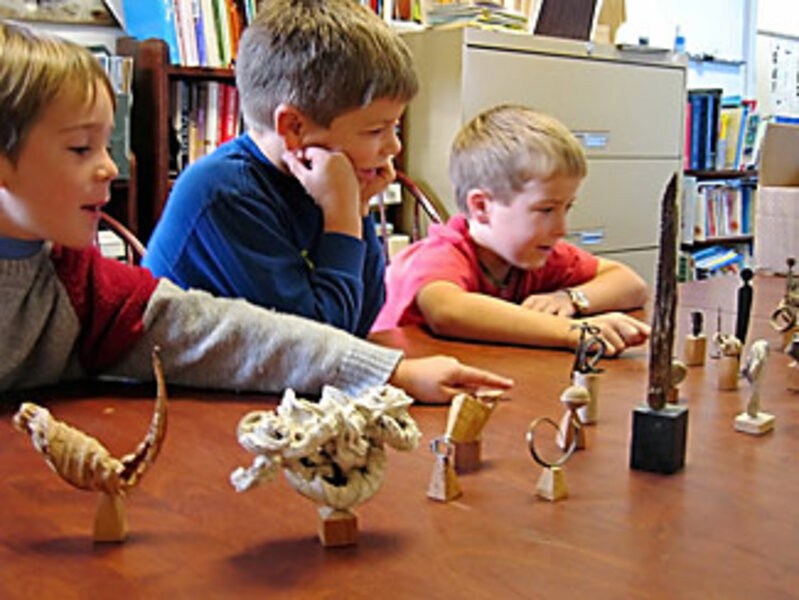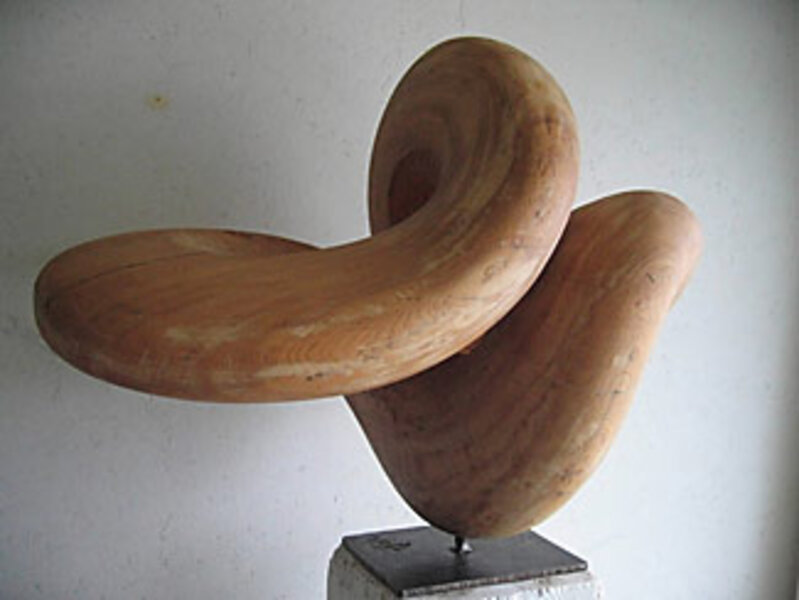The art of everyday items
Loading...
One thing just led to another after Liddy Fitz-Gerald visited the school where I'm principal with a box of miniature sculptures made by her husband, Clark. His full-size works can be found in public spaces ranging from Philadelphia to Coventry Cathedral in England. The table in my office became a minigallery of the 32 small objects that inspired huge public art.
At some point, Liddy had made up a word for them: jibbies. Here were nature's forms and functions isolated on a small wooden pedestal.
Among them were a stone with pebble-worn tunnels; a fossil clamshell; a sea purse (a purse-shaped egg case of sharks or rays); and the scroll of a leaf, its veins curled inward like a hand. Another leaf suggested the prow of a Viking longboat.
A chip of wood, a piece of bark, a dried starfish, and petrified worm castings – they had all interrupted a walk by Clark, who would pocket them for his collection and then reimagine them as monuments or soaring carvings. Even spirals of brass, snipped from some routine sheet that Clark was turning into an exotic form, were exalted when they became minute Möbius strips.
Of course, there are plenty of human forms walking around our town of Castine, Maine – flesh-and-blood jibbies, I suppose you'd call them, that have turned up in Clark's curvaceous carvings of elm trees. The town crew used to drop off massive tree trunks at his studio, salvaged from the dump for art's sake.
The kids at my school started to come by my office for a look at the jibbies. When second-grader Dustin saw them, he said, "You can make art out of anything." True, if you have the right eyes.
A walk with Clark, it turns out, wasn't about getting anywhere in particular – it was about seeing things. Really seeing things. Botany, paleontology, or geology might be the formal name for such science, but it's really a matter of art, poetry, and music – seeing, feeling, and hearing a different pulse in things.
So I opened the Clark Fitz-Gerald Table Top Gallery in my office. When Tom, a parent of a child in my school, saw it, he immediately appreciated the "childlike wonder" evident in Clark's choice of natural objects.
The kindergartners came two by two and looked at the little forms and the shadows they were making on the table. The children's faces were full of awe as they recognized familiar objects from their own experiences at beachcombing.
Where might this lead? I cut some wooden pedestals and started to hand them out as other classes came for a gallery visit.
Mrs. Belyea's art classes took up the work, gleaning along the town common and adjacent neighborhood for significant objets d'art. Within hours we had produced our own original jibbies: pebbles, maple leaves, horse-chestnut hulls, twigs, black-locust seedpods, lichens ... even a few bottle caps. Sculptures were to be found everywhere!
By Friday, Mrs. Pelletier's second- and third-graders were ready for a walk to the maritime academy across town in search of full-scale works by Clark. It wasn't hard to spot the curve of the mussel shell in the two-story welded weather-station sculpture, or the spiny sea urchin in the ornate grill above the library entrance. And in the lobby of one building, we recognized the whale vertebrae abstracted by Clark as an almost human shape. The kids pulled out their clipboards and got to work sketching. One good sculptural line deserved another at the end of a third-grader's pencil.
The appreciation and insight in our "strolls with Clark" reminded me of a sentence by physician and essayist Lewis Thomas, who could intertwine unheard melodies and things from the natural world in his musings. "If we had better hearing," he wrote, "and could discern the descants of sea birds, the rhythmic timpani of schools of mollusks, or even the distant harmonics of midges hanging over meadows in the sun, the combined sound might lift us off our feet."
Although Clark's been gone more than three years now, I like to think that he's just making art somewhere else.
The kids at my school carry on the local work. "Lifted" is the right word for our experience. We even put our jibbies on display alongside Clark's down at the public library.
A simple stroll on the common or down Court Street has yielded a new generation of jibbies: chestnut husks elevated to medieval armor, an elm leaf as imperial emblem, and a scrap of bark as winter ocean wave. Childlike wonder lives as we all take a walk with Clark, like Clark.
Do you hear timpani, too?






